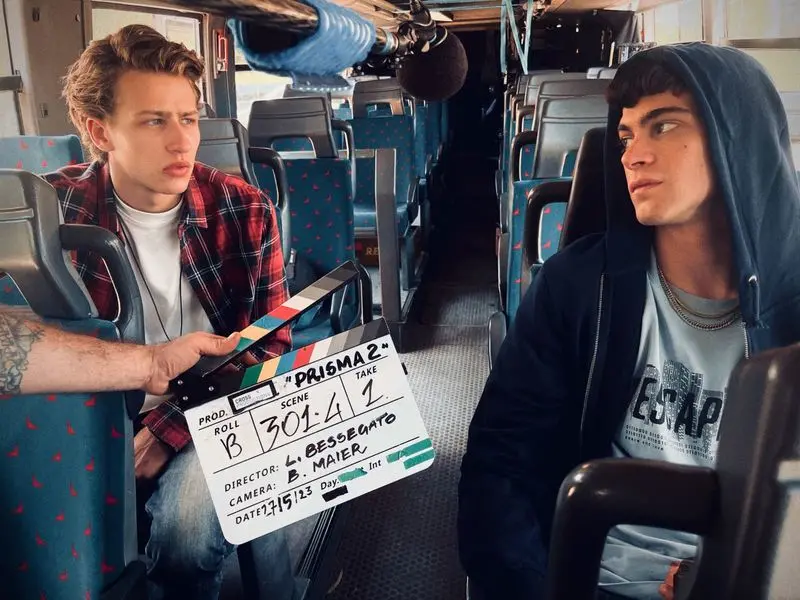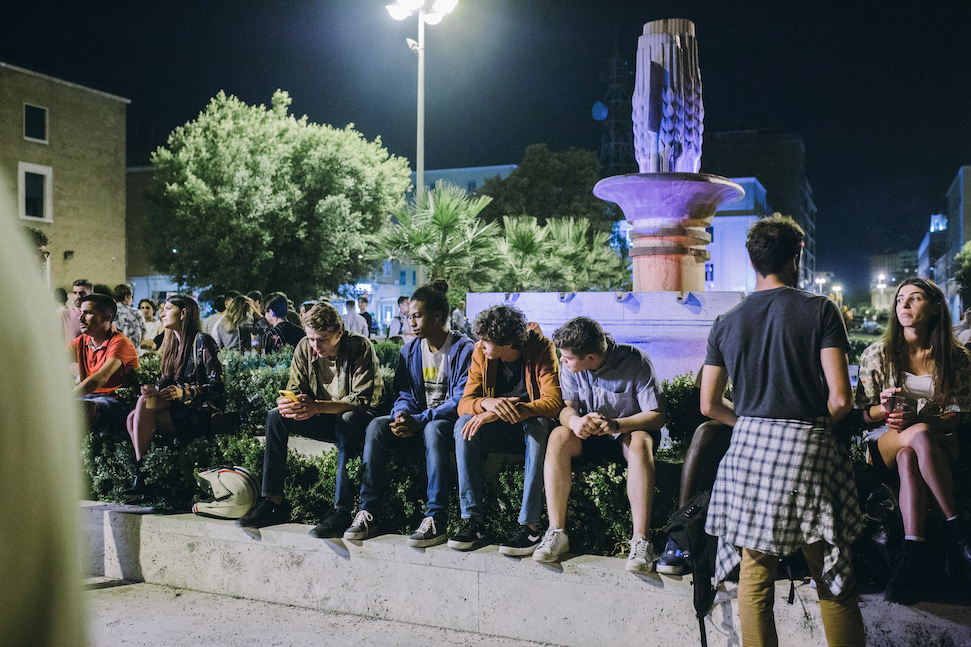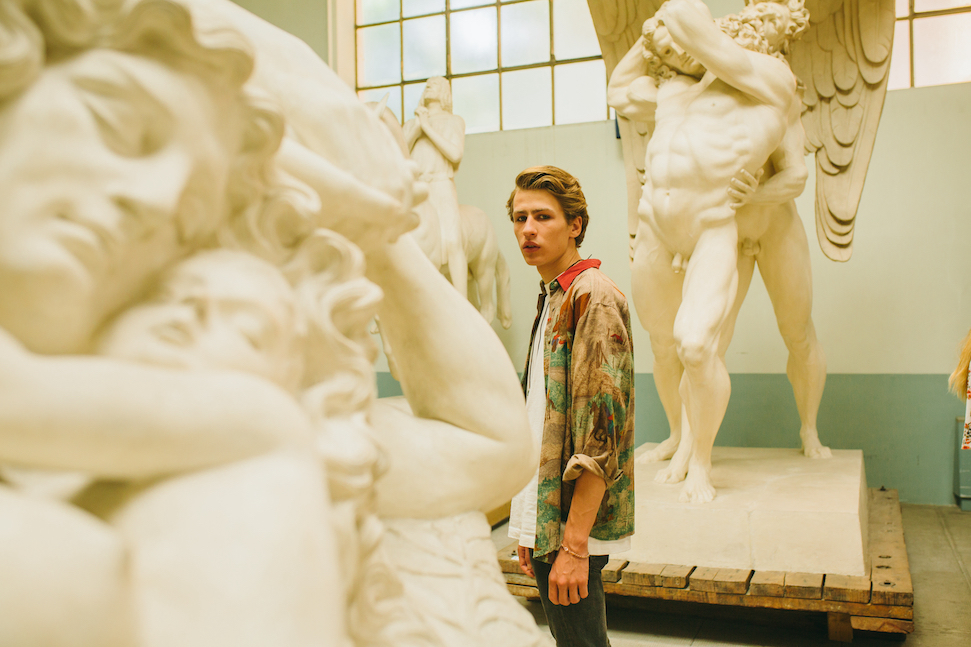

It is evening and the twins, Marco and Andrea (both played by Mattia Carrano), are preparing to celebrate their birthday: their friends are gathered in a crowded piazza della Libertà, one of the meeting points in Latina, dominated by a central fountain by Oriolo Frezzotti (1934) which recreates sheafs of grain. This is the opening of Prisma, a Prime Video series that delves into the lives of contemporary adolescents as they deal with the fears, challenges, self-discovery and awareness that demonstrate, as the story unwinds, how unique they all are.

Marco and Andrea while physically identical are very different in their anxieties. Their path of growth affects their whole group of friends, who, similarly, are all looking for their place in a fluid, continually changing world. The young characters live in a condition that is similar to the refraction of a crystal prism (the inspiration for the series title): just as the white light refracts into many colours so the adolescents want to express their own multifaceted personalities and avoid matching.
Latina was not a casual choice of setting; director Ludovico Bessegato considers it one of the lesser-known towns in Italy with an identity that is hard to pin down. A place full of colours, contrasts, beauty and degradation, modernity and nostalgia: “Latina is not like any other city in Italy. A countryside filled with wide open landscapes, green areas, pristine nature, that contrasts to the Brutalist architecture of housing estates, rows of terraced houses, a skyscraper and a nuclear power plant being dismantled”.
From the get-go, the colours that entitle the 8 episodes, the city in the Agro Pontino displays all its facets. Marco walks away from the group, Andrea follows him on a motorbike, which provides nocturnal views of: piazzale dei Bonificatori with palazzo delle Poste; the square porticoes of palazzo dell’Intendenza di Finanza; and, seen from above, piazza del Popolo with its harmonious lines of gardens, the so-called “ball fountain” at its centre, surrounded by imposing Rationalist buildings. After leaving a night club, Andrea stretches out on a bench in piazza San Marco, named for the nearby Cathedral which features later on for a funeral.
Moving away from the older squares which are the hub of the town’s nightlife, the skyline features the contemporary lines of torre Pontina in the business district (whose panoramic view from the top stuns Marco and Carola (Chiara Bordi) on their first date), the buildings in the Europa neighbourhood and via Bruxelles: Palazzo M in piazzale Araldo di Crollolanza is in the background when Andrea makes a phone call only to discover with disappointment that his confidante Raffa no longer volunteers at the LGBTQ+ Help Line; via Duca del Mare offers a glimpse of the tower of the aqueduct; and greenhouses and cultivated fields just beyond the urban boundaries.

Disused for over 30 years, the oldest nuclear power plant in Italy, in the hamlet of Borgo Sabotino, is also featured: Daniele (Lorenzo Zurzolo) is a member of a band – Klan Bruxelles – who shoot the video for their first song here.
Some of Episode 6 takes place in Rome: the windows of the train taking Nina (Caterina Forza) and Andrea to the city to attend a poetry reading show the parco degli Acquedotti. The two spend the day in the city: visiting the Casa Museo Hendrik Andersen, crossing the iconic bridge to Castel Sant’Angelo and passing through San Lorenzo, outside the Church of Santa Maria Immacolata e San Giovanni Berchmans. There’s time for an aerial shot of piazza Navona before going to Muccassassina, one of Italy’s most famous LGBTQ+ nights, held at Qube, a long-established club in via di Portonaccio.
Sabaudia is also featured: piazza del Comune and palazzo delle poste whose flowing, blue tiled, exteriors are used as the library where Micol (Elena Falvella Capodaglio) works; the coastal lakes; and the sand dunes of the seashore.
The Garden of Ninfa, in Cisterna di Latina, is at the heart of an event from Andrea’s childhood: fascinated since he was small by Ovid’s Metamorphoses, he intends to close a circle by meeting the object of his anxiety in this magic setting.
Andrea, Marco, Nina, Carola, Daniele, Micol, Vittorio, Ilo, Jun, Zelia. We left them at the end of season 1 facing the inevitable results of the profound existential changes set in motion at the beginning of the story.
In season 2 of Ludovico Bessegato's series for young adults, the kids from Latina will manage loves and desires, secrets and misunderstandings, and the deeper nuances of the infinite spectrum of colour that characterizes adolescence in the discovery of individual identity. None of them can hide their unacceptable love, talent, desire, instinct for self-destruction, mistakes or their unspeakable secrets.
The city in the Agro Pontino is still the centre of their world, featuring places seen in season 1 along with new settings - when Andrea's mother (Mattia Carrano) leaves her friends in piazza Dante after an evening in Rome, along with the recognizable municipal swimming pool, Manzoni high school, Hotel Fogliano, Latina Fiori shopping center, and Istituto comprensivo Giovanni Cena. Locations also included the hamlet of Foce Verde, near the Rio Martino pier, where Andrea meets Daniele (Lorenzo Zurzolo) on a bicycle.
Sabaudia features again, with shots of lake Paola and the seafront of Villa Carola among others. Emotional scenes involving the remains of a beached whale were filmed in Nettuno, near the Roman ruins of Torre Astura.
It is evening and the twins, Marco and Andrea (both played by Mattia Carrano), are preparing to celebrate their birthday: their friends are gathered in a crowded piazza della Libertà, one of the meeting points in Latina, dominated by a central fountain by Oriolo Frezzotti (1934) which recreates sheafs of grain. This is the opening of Prisma, a Prime Video series that delves into the lives of contemporary adolescents as they deal with the fears, challenges, self-discovery and awareness that demonstrate, as the story unwinds, how unique they all are.

Marco and Andrea while physically identical are very different in their anxieties. Their path of growth affects their whole group of friends, who, similarly, are all looking for their place in a fluid, continually changing world. The young characters live in a condition that is similar to the refraction of a crystal prism (the inspiration for the series title): just as the white light refracts into many colours so the adolescents want to express their own multifaceted personalities and avoid matching.
Latina was not a casual choice of setting; director Ludovico Bessegato considers it one of the lesser-known towns in Italy with an identity that is hard to pin down. A place full of colours, contrasts, beauty and degradation, modernity and nostalgia: “Latina is not like any other city in Italy. A countryside filled with wide open landscapes, green areas, pristine nature, that contrasts to the Brutalist architecture of housing estates, rows of terraced houses, a skyscraper and a nuclear power plant being dismantled”.
From the get-go, the colours that entitle the 8 episodes, the city in the Agro Pontino displays all its facets. Marco walks away from the group, Andrea follows him on a motorbike, which provides nocturnal views of: piazzale dei Bonificatori with palazzo delle Poste; the square porticoes of palazzo dell’Intendenza di Finanza; and, seen from above, piazza del Popolo with its harmonious lines of gardens, the so-called “ball fountain” at its centre, surrounded by imposing Rationalist buildings. After leaving a night club, Andrea stretches out on a bench in piazza San Marco, named for the nearby Cathedral which features later on for a funeral.
Moving away from the older squares which are the hub of the town’s nightlife, the skyline features the contemporary lines of torre Pontina in the business district (whose panoramic view from the top stuns Marco and Carola (Chiara Bordi) on their first date), the buildings in the Europa neighbourhood and via Bruxelles: Palazzo M in piazzale Araldo di Crollolanza is in the background when Andrea makes a phone call only to discover with disappointment that his confidante Raffa no longer volunteers at the LGBTQ+ Help Line; via Duca del Mare offers a glimpse of the tower of the aqueduct; and greenhouses and cultivated fields just beyond the urban boundaries.

Disused for over 30 years, the oldest nuclear power plant in Italy, in the hamlet of Borgo Sabotino, is also featured: Daniele (Lorenzo Zurzolo) is a member of a band – Klan Bruxelles – who shoot the video for their first song here.
Some of Episode 6 takes place in Rome: the windows of the train taking Nina (Caterina Forza) and Andrea to the city to attend a poetry reading show the parco degli Acquedotti. The two spend the day in the city: visiting the Casa Museo Hendrik Andersen, crossing the iconic bridge to Castel Sant’Angelo and passing through San Lorenzo, outside the Church of Santa Maria Immacolata e San Giovanni Berchmans. There’s time for an aerial shot of piazza Navona before going to Muccassassina, one of Italy’s most famous LGBTQ+ nights, held at Qube, a long-established club in via di Portonaccio.
Sabaudia is also featured: piazza del Comune and palazzo delle poste whose flowing, blue tiled, exteriors are used as the library where Micol (Elena Falvella Capodaglio) works; the coastal lakes; and the sand dunes of the seashore.
The Garden of Ninfa, in Cisterna di Latina, is at the heart of an event from Andrea’s childhood: fascinated since he was small by Ovid’s Metamorphoses, he intends to close a circle by meeting the object of his anxiety in this magic setting.
Andrea, Marco, Nina, Carola, Daniele, Micol, Vittorio, Ilo, Jun, Zelia. We left them at the end of season 1 facing the inevitable results of the profound existential changes set in motion at the beginning of the story.
In season 2 of Ludovico Bessegato's series for young adults, the kids from Latina will manage loves and desires, secrets and misunderstandings, and the deeper nuances of the infinite spectrum of colour that characterizes adolescence in the discovery of individual identity. None of them can hide their unacceptable love, talent, desire, instinct for self-destruction, mistakes or their unspeakable secrets.
The city in the Agro Pontino is still the centre of their world, featuring places seen in season 1 along with new settings - when Andrea's mother (Mattia Carrano) leaves her friends in piazza Dante after an evening in Rome, along with the recognizable municipal swimming pool, Manzoni high school, Hotel Fogliano, Latina Fiori shopping center, and Istituto comprensivo Giovanni Cena. Locations also included the hamlet of Foce Verde, near the Rio Martino pier, where Andrea meets Daniele (Lorenzo Zurzolo) on a bicycle.
Sabaudia features again, with shots of lake Paola and the seafront of Villa Carola among others. Emotional scenes involving the remains of a beached whale were filmed in Nettuno, near the Roman ruins of Torre Astura.
